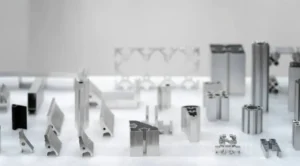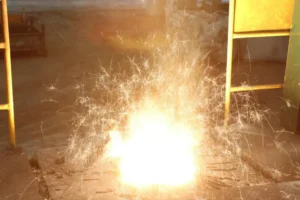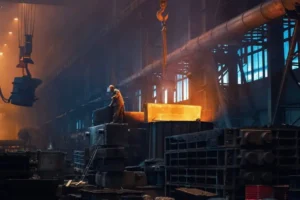
When evaluating an investment in an induction furnace, enterprises that focus only on the equipment’s purchase quote fall into the trap of “missing the forest for the trees.”
An induction furnace is a systematic engineering project, and its Total Cost of Ownership (TCO) far exceeds the initial purchase price.
The real costs are hidden in the various stages after the equipment is delivered.
Civil Engineering & Utilities
Equipment that cannot be properly “rooted” after purchase is worthless. Civil engineering and public auxiliary facilities (utilities) represent a massive and inflexible upfront investment.
- Workshop and Foundation:
- Load-Bearing Base: The induction furnace (especially a coreless induction furnace) is heavy, and its weight is enormous when filled with molten metal. A high-strength concrete foundation must be built to support the furnace body, hydraulic station, and power supply cabinet.
- Operating Platform: A sturdy steel or concrete operating platform must be erected to facilitate charging, temperature measurement, slagging, and pouring.
- Space Layout: The workshop must have sufficient height (for crane operation, charging) and space (for safe operation, maintenance).
- Cooling System (A Key Cost Point):
- The “heart” of the induction furnace—the power supply (Thyristor/IGBT)—and its “blood vessels”—the induction coil—both require forced water cooling.
- Cooling Tower / Closed-Loop System: Investment in a large cooling tower or a more expensive closed-loop cooling system (to prevent scaling in the waterways) is mandatory.
- Water Pool and Pump House: A large-capacity reservoir (or emergency/fire pool) and a pump house equipped with high-power pumps must be built to ensure water pressure and flow.
- Piping Engineering: Laying the complex network of inlet and outlet water pipes from the pump house to the furnace body and power cabinet is a significant installation project in itself.
- Dust Collection and Environmental Systems:
- Under current strict environmental regulations, fumes and dust generated during the melting process must be treated.
- Fume Hood: A well-designed fume hood (e.g., cyclone, side-draft) must be installed above the furnace mouth.
- Dust Collector Unit: Investing in a large baghouse filter or other high-efficiency dust collection equipment, along with matching fans and chimneys, is costly and requires continuous maintenance (like replacing filter bags).
Power Capacity Upgrades & Infrastructure
This is the most easily underestimated cost and the one most likely to “stall” a project. An induction furnace is an “energy hog,” and its power supply is its lifeline.
- Power Capacity Application Fee:
- Applying to the local power supply bureau to increase the electricity capacity (KVA) can itself be a huge expense, known as a “capacity fee” or “grid connection fee,” depending on local policies.
- High-Voltage Transformer:
- Induction furnaces typically require a dedicated high-voltage (e.g., 10kV or 35kV) transformer. Purchasing and installing a high-capacity (e.g., 2500 KVA, 5000 KVA) rectifier transformer is a major expense.
- Power Cabinets and Cables:
- Installation of high-voltage switchgear, low-voltage compensation cabinets (to improve the power factor, otherwise penalties are high), and the medium-frequency power supply cabinet is required.
- From the transformer to the power cabinet, and on to the furnace body, requires high-voltage cables or copper busbars with a very large cross-sectional area. Both the material and labor costs are extremely high.
Critical Reminder: In many cases, the total investment for power infrastructure (transformer + capacity fees + cabling) can even exceed the price of the induction furnace equipment itself. Full communication with the power supply bureau is essential from the project’s inception.
Operator Training & Safety
The equipment is static; the people are dynamic. The return on investment in operator training is extremely high, while the cost of neglecting it is catastrophic.
- Safety Training (The Lifeline):
- Explosion Prevention: Molten metal meeting water causes a violent explosion. Operators must be trained to strictly adhere to dry material protocols, check cooling water lines, and handle emergency water leaks.
- Electric Shock Prevention: Involving high voltage and medium frequency electricity, maintenance and operation must follow strict safety procedures.
- Burn Prevention: Training on protective measures during melting, slagging, and pouring.
- Skills Training (The Efficiency Line):
- Lining and Sintering: The quality of the furnace lining (ramming density, sintering curve) directly determines the furnace’s lifespan. A poor lining job will waste large amounts of refractory materials and production time.
- Melting Process: A skilled furnace operator knows how to mix charges, when to add materials, how to control power, and how to slag off, achieving the fastest melting speed and lowest energy consumption.
- Equipment Inspection: Training operators to perform daily checks (water pressure, water temperature, unusual noises, lining erosion) can identify faults early and prevent minor issues from becoming major accidents.
- Hidden Costs: Untrained employees lead to high energy consumption, short furnace life, frequent accidents, and low yield, all of which are continuous “bleeding” costs.
Spare Parts & Maintenance
An induction furnace is not a “one-and-done” piece of equipment; it has a large number of wearable parts and consumables.
- Refractory Lining (The Biggest Consumable):
- The furnace lining (quartz sand, alumina, etc.) is a consumable. Depending on the metal being melted and the frequency of operation, a lining’s life can range from tens to hundreds of heats.
- The company must continuously purchase refractory materials and bear the labor costs of lining and breakout, as well as the opportunity cost of downtime.
- Core Electrical Components:
- Thyristors (SCR) or IGBT Modules: The core of the power supply. They are expensive and can be damaged by overloads, poor cooling, or grid fluctuations.
- Capacitors: Compensation capacitors are wearable parts that degrade over time or fail (short circuit).
- Induction Coil (The Worst to Damage):
- If the induction coil (copper tube) is burned through due to a “run-out” (lining failure), the molten metal will destroy the coil. Repairing or replacing a coil is extremely expensive and involves very long downtime.
- Other Spares: Seals and valves for the hydraulic system, cooling water pumps, and control boards should all be kept in stock.
Long-Term Electricity Bills & Energy Consumption
This is the largest and most far-reaching component of the TCO. The “price difference” at the time of purchase can easily be erased by the “electricity bill difference” in the first year of operation.
- Power Consumption per Ton (kWh/ton):
- This is the core metric for an induction furnace’s efficiency. Different brands and technologies (e.g., old KGPS thyristor power supplies vs. new IGBT series-resonant power supplies) can have a difference of 5% or even 10%+ in power consumption per ton.
- Example: To melt 1 ton of steel, Furnace A uses 550 kWh, and Furnace B uses 600 kWh. Assuming an electricity price of $0.12/kWh, Furnace B costs (600-550) * 0.12 = $6 more per ton. If the annual output is 20,000 tons, Furnace B will cost an extra $120,000 per year in electricity alone.
- Power Factor:
- Older parallel power supplies might have a power factor of only 0.85-0.9, while modern series-resonant supplies can reach 0.97 or higher. A low power factor means significant reactive power losses, which are penalized by the grid, increasing electricity bills.
- Holding Power:
- When waiting to pour or adjusting composition, the furnace must be continuously powered to hold the temperature. Equipment with poor insulation and inefficient power supplies will have astonishingly high holding power consumption.
Conclusion: The Strategic Importance of TCO Decision-Making
When procuring an induction furnace, a company must never look only at the “equipment price” on the quotation sheet. A wise decision-maker must demand a complete TCO analysis from the supplier, which should at least answer the following questions:
- Power Requirements: What are your equipment’s specific requirements for the transformer and cables? What power factor can you guarantee?
- Infrastructure Needs: Please provide detailed civil engineering drawings for the foundation and the required configuration for the cooling water system.
- Energy Consumption Guarantee: Under my specific process conditions, what is your guaranteed “kWh/ton” consumption? (This is best written into the contract).
- Spare Parts List: What is the expected service life and replacement price for core wearable parts (lining, capacitors, IGBTs)?
- Training Services: What operational and safety training do you provide? Is it included or an extra charge?
Ultimately, a “cheap” induction furnace is very likely to become the company’s most “expensive” burden after commissioning, due to high electricity bills, frequent maintenance downtime, and extremely short lining life.







